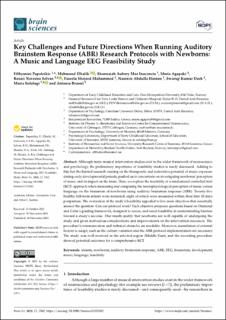| dc.contributor.author | Papatzikis, Efthymios | |
| dc.contributor.author | Elhalik, Mahmoud | |
| dc.contributor.author | Inocencio, Shannaiah | |
| dc.contributor.author | Agapaki, Maria | |
| dc.contributor.author | Selvan, Rosari | |
| dc.contributor.author | Muhammed, Faseela | |
| dc.contributor.author | Haroon, Nazreen | |
| dc.contributor.author | Dash, Swarup | |
| dc.contributor.author | Sofologi, Maria | |
| dc.contributor.author | Bezoni, Antonia | |
| dc.date.accessioned | 2023-02-23T09:58:21Z | |
| dc.date.available | 2023-02-23T09:58:21Z | |
| dc.date.created | 2021-11-26T12:46:06Z | |
| dc.date.issued | 2021-11-26 | |
| dc.identifier.citation | Brain Sciences. 2021, . | en_US |
| dc.identifier.issn | 2076-3425 | |
| dc.identifier.uri | https://hdl.handle.net/11250/3053528 | |
| dc.description.abstract | Although many musical intervention studies exist in the wider framework of neuroscience and psychology, the preliminary importance of feasibility studies is rarely discussed. Adding to this fact the limited research existing on the therapeutic and restorative potential of music exposure during early developmental periods, pushed us to concentrate on investigating newborns’ perception of music and its impact on the brain. Here, we explore the feasibility of a randomized controlled trial (RCT) approach when measuring and comparing the neurophysiological perception of music versus language on the brainstem of newborns using auditory brainstem response (ABR). Twenty-five healthy full-term infants were recruited, eight of which were measured within their first 10 days postpartum. The evaluation of the study’s feasibility appealed to five main objectives that essentially answer the question: Can our protocol work? Each objective proposes questions based on Orsmond and Cohn’s guiding framework, designed to assess, and assist feasibility in understanding barriers toward a study’s success. Our results justify that newborns are well capable of undergoing the study and given meticulous considerations and improvements on the intervention resources. The procedure’s communication and technical obstacles are resoluble. Moreover, assimilation of external factors to adapt, such as the culture variation and the ABR protocol implementation are necessary. The study was well received in the selected region (Middle East), and the recording procedure showed potential outcomes for a comprehensive RCT. | en_US |
| dc.language.iso | eng | en_US |
| dc.publisher | MDPI | en_US |
| dc.relation.ispartofseries | Brain Sciences;Volume 11 / Issue 12 | |
| dc.rights | Navngivelse 4.0 Internasjonal | * |
| dc.rights.uri | http://creativecommons.org/licenses/by/4.0/deed.no | * |
| dc.title | Key Challenges and Future Directions When Running Auditory Brainstem Response (ABR) Research Protocols with Newborns: A Music and Language EEG Feasibility Study | en_US |
| dc.type | Peer reviewed | en_US |
| dc.type | Journal article | en_US |
| dc.description.version | publishedVersion | en_US |
| dc.rights.holder | © 2021 by the authors | en_US |
| dc.source.articlenumber | 1562 | en_US |
| cristin.ispublished | true | |
| cristin.fulltext | original | |
| cristin.qualitycode | 1 | |
| dc.identifier.doi | https://doi.org/10.3390/brainsci11121562 | |
| dc.identifier.cristin | 1959723 | |
| dc.source.journal | Brain Sciences | en_US |
| dc.source.volume | 11 | en_US |
| dc.source.issue | 12 | en_US |
| dc.source.pagenumber | 1-16 | en_US |

